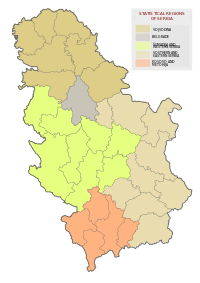Varvarin
| Varvarin Варварин | ||
|---|---|---|
| Municipality and Town | ||
|
House of Culture in Varvarin | ||
| ||
 Location of the municipality of Varvarin within Serbia | ||
| Coordinates: 43°43′N 21°22′E / 43.717°N 21.367°ECoordinates: 43°43′N 21°22′E / 43.717°N 21.367°E | ||
| Country | Serbia | |
| District | Rasina | |
| Settlements | 21 | |
| Government | ||
| • Mayor | Zoran Milenković (SPO) | |
| Area[1] | ||
| • Municipality | 249 km2 (96 sq mi) | |
| Population (2011 census)[2] | ||
| • Town | 2,133 | |
| • Municipality | 17,772 | |
| Time zone | CET (UTC+1) | |
| • Summer (DST) | CEST (UTC+2) | |
| Postal code | 37260 | |
| Area code | +381 37 | |
| Car plates | KŠ | |
| Website |
www | |
Varvarin (Serbian Cyrillic: Варварин, pronounced [ʋarʋǎriːn]) is a small town and municipality in the Šumadija region of central Serbia. Population of the town is 2,133, and population of the municipality is 17,772. It is part of the Rasina District of Serbia.
History
The town is notable as the site of an 1810 battle during the Russo-Turkish War (1806-1812) between the Ottoman Empire and a combined Russian and Serbian army. A statue to the Russian commander Joseph Cornelius O'Rourke and his men was erected in 1910 on the centenary of their victory in the battle, which freed the city from Turkish domination.
From 1929 to 1941, Varvarin was part of the Morava Banovina of the Kingdom of Yugoslavia.
NATO attack
During the Kosovo war and the break-up of Yugoslavia in the late 20th century, the area became engulfed in conflict although distant from the border. On a clear Sunday, 30 May 1999, shortly after 1 p.m., a bridge crossing the Velika Morava river in Varvarin was struck by laser-guided bombs fired by one or two low-flying NATO F-16 warplanes conducting attack operations. The area around the bridge was filled with hundreds of people celebrating an Orthodox holiday in and around the nearby church, a market place, and a fairground.
No precautions against air attacks had been taken, as the town is far from Kosovo (approximately 200 km), the aged and narrow bridge was considered insignificant, and no military installations were within a radius of 20 km. Ten civilians were killed and 17 severely injured, in two attack waves a few minutes apart. Most of the casualties occurred in the second wave, when people had rushed to the bridge to help those wounded in the initial wave. Some survivors were left with permanent disabilities,
To this date, NATO has refused to release further details of the airstrike – specifically the nationality of the attacking planes. In a public statement made by NATO spokesman Jamie Shea on 31 May 1999, he declared the Varvarin bridge a legitimate military target. No explanations or other statements have been issued by NATO since then.
The airstrike gave rise to a lawsuit against the German government (one of the NATO countries involved in the conflict). The case was decided against the Serbian plaintiffs, but it is under appeal to Germany's highest court.[3][4][5][6]
Twin cities
See also
References
- ↑ "Municipalities of Serbia, 2006". Statistical Office of Serbia. Retrieved 2010-11-28.
- ↑ "2011 Census of Population, Households and Dwellings in the Republic of Serbia: Comparative Overview of the Number of Population in 1948, 1953, 1961, 1971, 1981, 1991, 2002 and 2011, Data by settlements" (PDF). Statistical Office of Republic Of Serbia, Belgrade. 2014. ISBN 978-86-6161-109-4. Retrieved 2014-06-27.
- ↑ 2003-10-15 "Serbian Families Sue Germans Over NATO Bombing", Deutsche Welle World Service
- ↑ "1999-05-31 NATO bombers hit town `full of people'", The Irish Times
- ↑ BBC news report, 1999-05-31
- ↑ Photos of the effects of NATO bombing on Varvarin bridge, NATO Tribunal
External links
| Wikimedia Commons has media related to Varvarin. |




